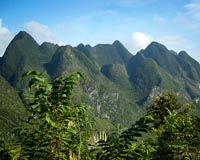 |
Calgary, Canada (SPX) Mar 30, 2011 Canadians have always seen themselves as separate and distinct from their American neighbours to the south, and now they have geological proof. New research published in April's edition of Geology shows that rock formations roughly along the same political boundary as the two North American countries formed as early as 120 million years ago. Dr. Andrew Leier, of the Department of Geoscience at the University of Calgary, set out to prove what he thought was the obvious: because the mountains are continuous between the U.S. and Canada, the ancient river systems that flowed from these uplands were likely interconnected. In other words, during Cretaceous Period,120 million years ago, rivers should have flowed north and south between the countries, paying no mind to the modern day political border. "I thought that I could easily show that in my research," says Leier who published a paper in Geology with co-author Dr. George Gehrels at the University of Arizona and, Leier adds, a lot of help from Cassandra Frosini, an undergraduate in geoscience at the University of Calgary. But Leier was wrong. "I was surprised to learn the opposite, in fact, was true," he says. A tiny piece of sediment found in sandstone called zircon helped the researchers locate where the sediments had originally formed. Knowing its current location, Leier was able to determine just how far the rivers moved it and the direction from which it came. During the Cretaceous Period, mountains were being created all along western North America, in both Canada and the United States. "I thought the sediment transported by ancient rivers in Montana and Utah would flow out of the mountain ranges and then north into Alberta. This is similar with how the Ganges River runs parallel to the Himalayas. Our research shows this wasn't the case," says Leier. Leier and Gehrels used recently developed laser-based techniques to reconstruct the origin of individual sand grains that were deposited during this period in western North America. This technique has applications to the petroleum industry as well, where it can be used to aide in determining drilling locations. Researchers found slightly different rocks, when eroded, produced slightly different zircons. "Cretaceous sediment in the United States have a clear American signature; whereas those in the Canadian Rockies have a different and definable Canadian signature," says Leier. "The demarcation is pretty much coincidental with the modern day border." Also the implication of the data suggests that the rivers that flowed west to east from the mountains in the United States stayed in the United States, and those in Canada stayed in Canada. "In other words, there is no evidence that rivers in western North America were crossing what is today the border," says Leier. The paper, Continental-scale detrital zircon provenance signatures in Lower Cretaceous strata, western North America, published in Geology is by Andrew Leier, Department of Geoscience, University of Calgary and George Gehrels, Department of Geosciences, University of Arizona.
Share This Article With Planet Earth
Related Links University of Calgary Explore The Early Earth at TerraDaily.com
 Algae And Bacteria Hogged Oxygen After Ancient Mass Extinction
Algae And Bacteria Hogged Oxygen After Ancient Mass ExtinctionStanford CA (SPX) Mar 28, 2011 A mass extinction is hard enough for Earth's biosphere to handle, but when you chase it with prolonged oxygen deprivation, the biota ends up with a hangover that can last millions of years. Such was the situation with the greatest mass extinction in Earth's history 250 million years ago, when 90 percent of all marine animal species were wiped out, along with a huge proportion of plant, ani ... read more |
|
| The content herein, unless otherwise known to be public domain, are Copyright 1995-2010 - SpaceDaily. AFP and UPI Wire Stories are copyright Agence France-Presse and United Press International. ESA Portal Reports are copyright European Space Agency. All NASA sourced material is public domain. Additional copyrights may apply in whole or part to other bona fide parties. Advertising does not imply endorsement,agreement or approval of any opinions, statements or information provided by SpaceDaily on any Web page published or hosted by SpaceDaily. Privacy Statement |